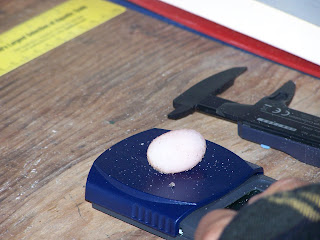As of September 1, we've had 5 nests hatch and we've had an 89% hatch success rate to date. With a cooler August, we will have hatching and emergence into late September this year. Below are some hatchlings making their way to the marsh.
 |
| Terrapin Hatchlings at N. Sedge Island on August 30, 2013 |
That was it! Sixty-six total terrapins and only 29 nests at N. Sedge Island. It is significantly lower in both captures and nests than in past seasons. More to follow...
As on July 25, we have a total of 66 nesting females marked and 29 nests moved on Sedge Island. Since we are at the end of the nesting season, this may be our final tally at N. Sedge Island. My counterpart on LBI has over 1400 terrapin eggs rescued this year. Great job to her and the dedicated volunteers that may help to save this species from being extirpated at Barnegat Bay. Hatching to follow...
As of June 19, 2013, we have over 20 nesting female marked and six nests moved on Sedge Island. Kathy Lacey reported that over 400 eggs were moved to the hatchery on High Bar Harbor on LBI. See our marked #16 female terrapin. We marked them with a number after taking our annual measurements so that the female terrapin can nest, possibly come back, and we will not have to disturb her again. Dont' worry, the paint is temporary and usually only lasts two weeks. See some neat pictures below...
Female terrapin (#16) on N. Sedge Island
Clutch of 11 eggs moved from construction on
the east lawn to the hatchery.
Annalee measuring eggs as part of the nesting
ecology study at N. Sedge Island.
Terrapin egg being massed at N. Sedge Island
We are in the midst of nesting season with three nests moved today and a total of 11 terrapins marked for the season. All eleven occurred this week. Much more to follow...
Nesting season kicked off with a flury of activity! This past week has been busy in many locations. We've only had three terrapins at N. Sedge Island so far, but have seen activity along Island Beach State Park. Our LBI nesting area is extremely active. Kathy and her volunteers are working very hard to move nests to the hatchery.
Female terrapin nesting at Island Beach State Park
on June 12 (code CIJVW) marked back in 2007.Notice the peeling outer layers of carotene on her
scutes? This is normal as she has indeterminant
growth (sometimes < 1mm per year).
Sadly, we've also had reports and encounters with terrapin boat and road mortality. A large female terrapin was hit by a boat on Sunday June 9 and another on June 11 (all off LBI). There have also been at least a dozen terrapins or more hit since this past Saturday on LBI and Tuckerton. Please be terrapin aware!
We kicked off the 2013 nesting season by releasing 52 "yearlings" at Island Beach State Park that were hatchlings from the Sedge Island Wildlife Management Area rescued in early October 2012. Some of the terrapins were found also immediately after storm Sandy and released back to their homes. Thanks to Lacey Middle School, Girard College School (PA), Lavallette Elementary School, Barnegat High School, Southern Regional High School, MATES and Jenkinson's Aquarium for their caring and raising of the hatchlings this year (photos below)...
MATES Project Terrapin Hatchling Team at the release
Lacey Middle School "yearlings"
Summer assistants Alex and Annalee marking hatchlings

Students releasing terrapins
Terrapin making its way back home!
We also are ready at Sedge for the 2013 nesting season. It is up to the terrapins now!















